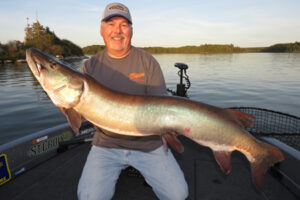By Steve Heiting
Why on Earth would a Wisconsinite travel to go musky fishing? After all, nowhere else are there as many musky waters in such close proximity as in this state. Incredibly, there exist more than 350 musky lakes within a 60-mile radius of the little town of St. Germain in Vilas County!
There are four very good reasons to travel. First, it’s always cool to see “new” water and try to figure out how to catch muskies there. The broader your experiences, the better fisherman you’ll become. Second, while big muskies are caught every year in Wisconsin, other locales with larger waters tend to produce them more consistently. Third, by fishing in different places you’ll learn new ways to catch muskies that will also work on your home waters. Finally, the fourth reason is the season is open year-round as soon as you hit the Illinois border, and it’s always fun to travel south to catch muskies when you can’t legally fish for them back home.

It can all be very confusing when you start traveling to fish muskies, but I’ll try to guide you through the process. Researching far-away waters is so much easier now than when I started fishing out of state. The Internet and social media put scads of data at your fingertips. Information about the lakes themselves, as well as guides and resorts, is there for the asking. Lake maps are better than ever, and with mapping GPS there’s almost no way an angler can get lost on even the largest lake. If you really want to get a better idea of the layout of a fishing spot than what is offered on a printed map, online maps or even satellite imagery may provide it.
To determine when to go, ask yourself what you hope to accomplish by traveling. If you are suffering from cabin fever and just want to go musky fishing, then a southern reservoir is your destination. The best time to go is from when flood waters recede in spring until early summer, and then again in fall. You won’t want to go in midsummer because high water temperatures make fishing difficult, and muskies are harder to release.
If you want to make a trip to northern Minnesota or Canada, it’s usually best to wait until the water warms up in midsummer before you go. Minnesota remains a viable option well into fall, but Canada is less so because few resorts close in September. Michigan’s Lake St. Clair tends to produce muskies all season.
Just like in Wisconsin, some destination waters are better at producing numbers of muskies rather than big fish, while other lakes and streams grow fewer but bigger muskies. Typically, waters that produce smaller muskies are small themselves, so they tend to warm up and turn on earlier in the season. Trophy waters, on the other hand, tend to be larger and deeper, so they really won’t start producing until later in the season.
Hiring a guide is a great option to learn a new water, but do your homework on the guide first. Guides who work for resorts may actually spend more time on walleyes and other species, and only occasionally hunt muskies. While you may be disappointed with the guide’s musky experience, a day with him may still be beneficial if you end the day feeling comfortable with the lake. Line up your lodging and guide early to get the days or week you want because the best of each book up quickly.
Next, buy the best map you can find of the lake. Understand that no single map service provides the best map of all musky waters. One company may print the best map or produce the best mapping chip for one lake, but another company may have a better option for another water. Since electronics are not foolproof, use a printed map in conjunction with a mapping chip in your GPS.
The printed map becomes your “Bible” of the lake. Mark the boat landing and/or resort on it, and add a waypoint for such locations to your GPS. Every contour, weedbed, rock structure, fish crib, fallen tree, etc., should be added to your map as you find them. On a smaller lake you can place your boat on the outside weed edge and then drive its perimeter in a few short hours, watching your depthfinder the entire time to learn the bottom’s secrets.
Side-imaging is a tremendous feature if your sonar unit has it. Draw the features you find to your printed map as you discover them, and your map becomes better with each one. Use waypoints on your GPS to mark such locations, too.
What you should take on the trip requires as much planning as the water you will fish. The more remote the location, the less likely you’ll find tackle shops or a discount store to pick up something you need but left back home. It’s best to bring with you every lure and rod-and-reel combination you may need for any possible scenario. For example, if you’re traveling to a Canadian lake where the majority of summer muskies are caught on bucktails, you still need to bring a selection of crankbaits and jerkbaits should the muskies demand something you didn’t expect.
The same rule applies to your boat and personal gear. In most locales, if your boat has the safety equipment required in Wisconsin, you’re also good to go there. Don’t forget ropes and bumpers for tying off your boat at the dock, and a battery charger and long extension cord will be necessary. Pack clothing for every possible weather event, and don’t skimp on your rainsuit or footwear. Nobody can enjoy a fishing vacation while wet and chilled, or dealing with sore feet.
Seeing new water, learning different techniques, and catching big muskies are among the many benefits of the traveling musky hunter. Chances are that after going on one trip you’ll find yourself planning your next.
